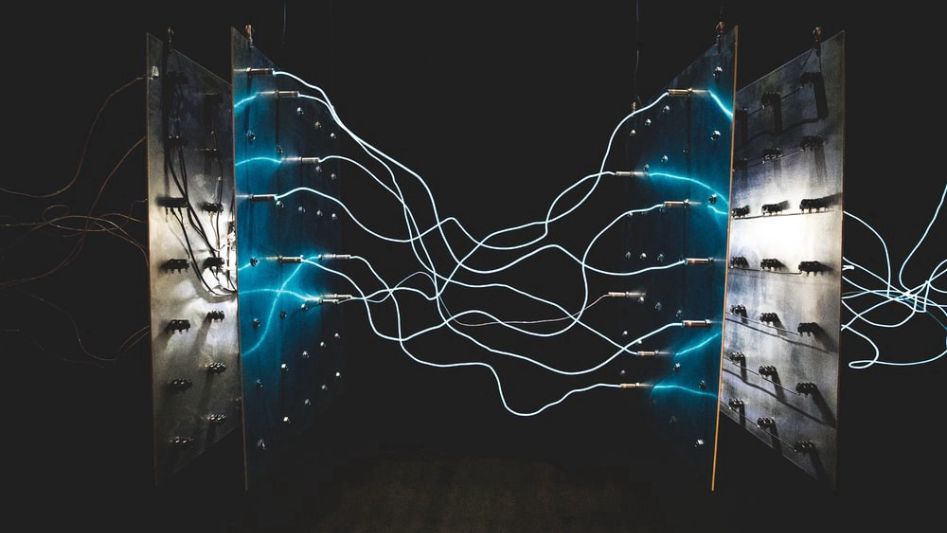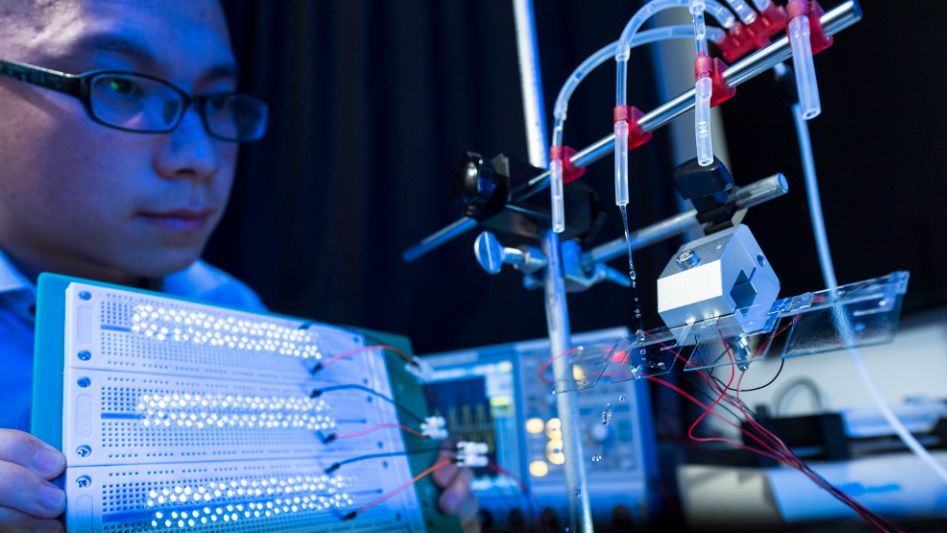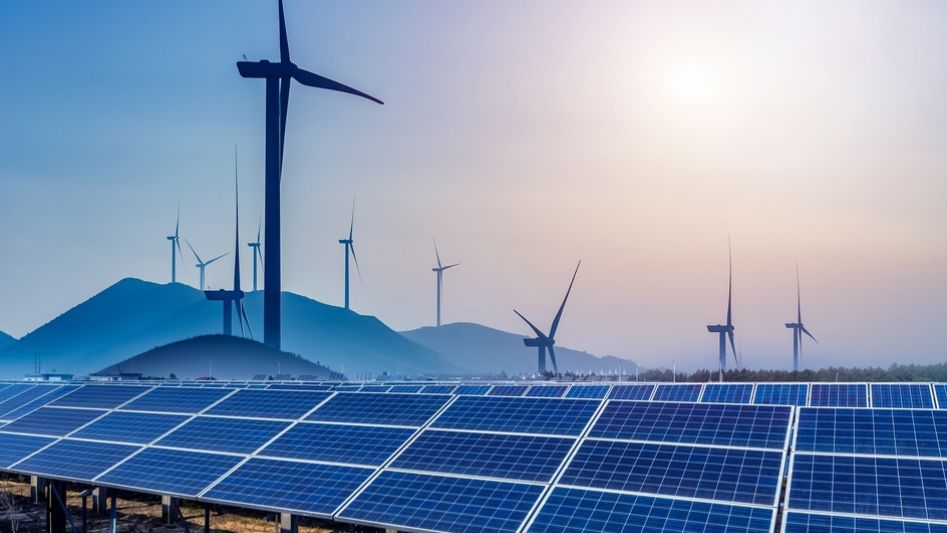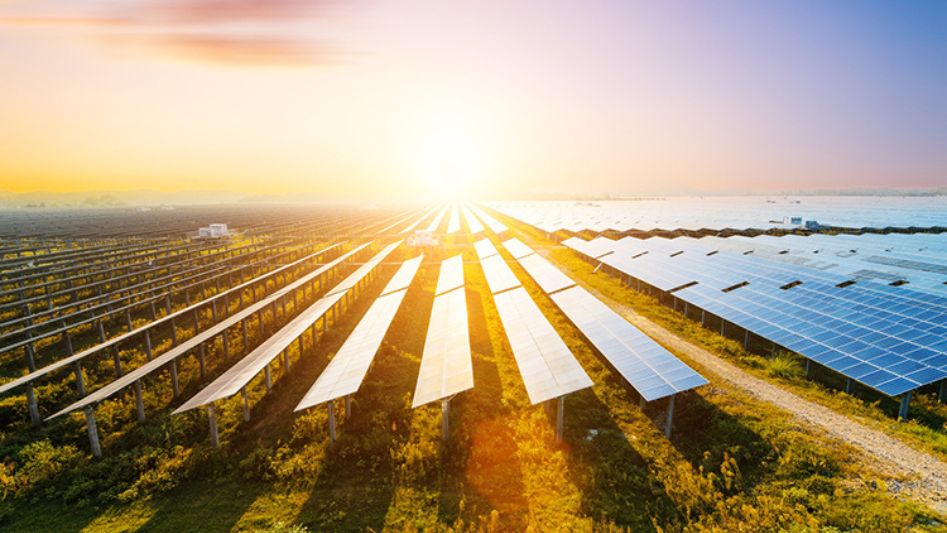Researchers from the American University of Massachusetts Amherst have invented a device Air-gen, that uses a natural protein to create electricity from humidity in the air.
Table Of Content
- Content
- Field tests are currently taking place
- The Principle of inductive coupling is established
- 20 hours of electricity are currently supplied by Airgen
- Conclusion
- FAQ
- You May Also Like
- External Links
Mobility in technology is expanding. The power supply is proving to be a bottleneck for emerging technologies such as electric cars, autonomous systems, robotics, wearables, and mobile electronic gadgets. This is because of the limitations posed by batteries in terms of portability and versatility due to their size, weight, capacity, and charging time. The solution to this problem might be the incorporation of a power generator within the mobile gadget or the transfer of energy wirelessly.
We invite you to read: “Wind Is Now South Dakota No.1 Electricity Generator”

Transmission of electricity via vacuum is not novel. For almost 4.5 billion years, the sun has repeated this process. But there are huge losses; most of the sun’s radiated energy is lost in space, and only a minuscule portion reaches the celestial worlds that circle it, and only a fraction of that can be subsequently harnessed. The same holds true for long-distance wireless energy transfer on our planet: Their efficiency (the amount of energy produced relative to the amount of energy used) is considerably below 1% and decreases dramatically with increasing distance.
Electromagnetic energy bundling is one possible approach. This is why Emrod, a cleantech business launched in 2019 and headquartered in Auckland, New Zealand, uses a beam-forming process to transform DC current into a directional electromagnetic beam with a parallel polarization. Within a year of its inception, Emrod demonstrated proof-of-concept for wireless power transfer with a beamforming efficiency of more than 97%. Greg Kushnir, the company’s founder and CEO, discusses the groundbreaking development in detail: “Using electromagnetic metamaterials, we are able to attain such great efficiency.” Using these, we may tightly concentrate the antenna’s EM power for transmission. “We are certain that with more enhancements on both the transmitting and receiving ends of the system (where the largest losses now occur), we will be able to achieve an overall efficiency of over 80%.” Power transmission efficiency across high-voltage lines typically ranges from 60% to 95%, depending on the nation and taking losses like power theft into account. Metal-plastic composites and other metamaterials exhibit “unnatural” optical, electrical, and magnetic capabilities. When the repeating structures inside them are smaller than the wavelength, they cause electromagnetic waves to behave in unexpected ways. To avoid being detected by radar, metamaterials may deflect the beams of the detection device around themselves.
Field tests are currently taking place
To block, diminish, magnify, or divert electromagnetic radiation, Kushnir adds, “the metamaterials that we design and manufacture are defined by their smart qualities, such as exact form, geometry, size, orientation, and arrangement.” Wireless power transfer in Emrod occurs at 5.8 gigahertz. This band of frequencies is utilized for a wide variety of weather-independent technologies, including radar, directional radio, WLAN, and Bluetooth. Emrod’s beam-forming technique creates a tightly concentrated “rod” of energy that travels from the transmitter to the receiver through a series of relay antennas. The “Em” in “Emrod” stands for electromagnetic, while the “rod” in “rod” refers to the company’s primary product. Emrod is working with New Zealand’s Powerco to produce a bigger indoor prototype and a wireless system that may be used to extend Powerco’s supply network. As a result of this method, costly copper cable construction in challenging terrain may be avoided, allowing electricity to reach previously unreachable places. The wireless solution also reportedly reduces maintenance costs and has less of an effect on the environment. For Kushnir, “wireless power transmission presents itself as a significant technology for conveying energy to the customer in a sustainable manner,” particularly for renewable electricity production. This is because cable transport necessitates a great deal of room for substations and transmission line towers, as well as a great deal of materials like copper and steel, as well as a great deal of maintenance and repair labor.
Permanent Emrod devices may be used in places where running wires would be too expensive, too time-consuming, or both.
Using radio waves to transfer power over relatively short distances is commonplace at this point. Technical effort, like Emrod’s highly specialized antenna design, is required to minimize losses in long-distance wireless transmission of energy. However, if the distance between the transmitter and receiver is merely a few centimeters, low-loss energy conveyance in the air may be easily implemented and is now state-of-the-art. Two coils placed at a close distance from each other may act as both a transmitter and a receiver.
We invite you to read: “The Great Clean Energy Acceleration: All You Need to Know”
The principle of inductive coupling is established
Inducing a voltage that is also alternately rising and falling, the receiver coil responds to an alternating current flowing through the transmitter coil. Inductive coupling is already used in wireless charging stations for electric toothbrushes and cellphones. The technology to wirelessly transfer electric power with great efficiency up to two meters is now available on the market. In addition, passive RFID transponders (RFID = radio frequency identification) are widely used since they do not need a battery or other external power source. The small transponders have several applications, including but not limited to use as smart cards for access control, automobile immobilizers, animal identifier implants, and radio tags for labeling items. The reading device’s beams not only carry data but also power the transponder. Transrapid, a German high-speed monorail train that uses magnetic levitation, is also supplied with wireless power by inductive coupling. In the future, this technology will certainly become crucial for electric vehicles. The battery life of a vehicle may be increased by thousands of kilometers if it were to be able to recharge itself while traveling on a charging lane of a road that had implanted coils or plates. E-mobility and industrial applications provide an enormous challenge, well beyond that of RFIDs and portable electronics. With just 5 watts of electricity, a smartphone’s battery may be swiftly recharged. A thousand times more wireless power must be accessible for electric cars, autonomous mobile robots, floor conveyors, and other industrial equipment. The development of such systems has only begun. However, researchers from the University of Colorado Boulder in the United States have recently demonstrated a test apparatus that can broadcast 1 kilowatt across a distance of 12 centimeters.
Physicist Jun Yao and microbiologist Derek Lovley have created an air-powered generator. The generator draws electricity from atmospheric water vapor by connecting electrodes to protein nanowires.
Instead of using inductive coupling, which relies on a low-frequency electric field to transmit energy, the team here used capacitive coupling. If the concept is to be optimized and scaled to industrial practice, additional feasibility studies will need to demonstrate this. After all, the manufacturing and processing industries need not only microcontrollers with embedded intelligence to improve energy transfer but also standardized designs and components that can endure the extreme circumstances of industrial production.
When machines, warehouses, commercial vehicles, robots, and sensors are no longer tethered together by wires, only then can their full potential as part of the Industrial Internet of Things (IIoT) be realized, according to experts. This not only makes them more portable and flexible to use, but also more dependable and low-maintenance, since there are no plugs or sockets to cause contact difficulties or leaks. The use of wireless power transfer may, however, be a temporary solution. Developed by UMass Amherst researchers, Air-gen is a tiny generator the size of a fingernail that extracts energy from atmospheric moisture to create electricity. Using protein nanowires made by the bacterium Geobacter, the team headed by microbiologist Derek Lovley and physicist Jun Yao creates electrical conductors. The protein nanowires that make up Air-gen are around 8 micrometers in thickness (e-PNs). The e-PNs set up a porous network of nanochannels that water molecules may pass through. The film is grown on a gold electrode that is 5 millimeters on each side. Water from the air is absorbed by the film and then transported via the channels below, where a smaller gold electrode (11 millimeters) covers just part of the film. A steady concentration gradient is maintained because water has a more difficult time penetrating thicker layers.
20 hours of electricity are currently supplied by Airgen
Assistant professor Yao in the field of Electrical and Computer Engineering elaborates on how electricity is produced: “When a water molecule bonds to an e-PN, the e-PN gains a partial electric charge.” “The film’s charge density is higher in its top layers than in its lower layers due to the concentration gradient, which causes a voltage to be generated between the electrodes and a current to flow through the film.” The Air-Gen prototype can keep low-voltage electrical components running for 20 hours on a single charge. The mini-cell must then rest for approximately 5 hours in humid air before repeating the process.By simulating e-PN qualities, the Amherst group thinks it can boost output power by a large margin and, by stacking multiple Air-gens, even outdo the power density of solar cells. Here are some of Air-Gen technology’s benefits over other forms of renewable energy generation: Air-gen is always on since humidity is prevalent everywhere (even inside), and it doesn’t care what the weather is like outside. “Air-gen provides for ecologically friendly energy generation that is significantly less confined by location or environmental circumstances than other sustainable alternatives,” says Professor Lovley, director of the Department of Microbiology. Tiny Air-gen units are now being developed to power wearables like health and fitness monitors and smartwatches, and subsequently, by combining many units, smartphones will be able to function without batteries. For the foreseeable future, Yao adds, “our objective is to have highly scaled commercial units that make a major contribution to sustainable electricity production.” Furthermore, Lovley says, “When it comes to the technological mass manufacturing of e-PNs, Geobacter is not a good fit.” Therefore, we engineered the far more robust bacterial species Escherichia coli (E. coli) to mass-produce e-PNs. Glycerol, a byproduct of biodiesel manufacturing, is used to cultivate E. coli cultures in vast numbers at a cheap cost. In doing so, the ground is paved for the long-term mass manufacture of air-gen generators using renewable feedstocks. It will take years of development to determine whether this concept will remain a niche technology or have a significant impact on the industrial and daily worlds.
Conclusion
Solutions exist that may increase manufacturing rates, and micro-bottlenecks are nothing new in the cutting-edge field of nano-scale energy solutions. This clean power can be generated cheaply using inert carbon electrodes. Unlike solar and wind energy, air-generated energy may be used even when there is no natural light or breeze. It can generate power even in dry environments like deserts, yet it functions just as well inside. The next phase of the study is to create an Air-Gen patch that can charge electronic gadgets like health monitors, smartwatches, and mobile phones, eliminating the need for batteries and regular charging.
We invite you to read: “Can Wind Turbines Withstand Hurricanes?”
FAQ
Do you think it’s possible to generate power from nothing but air?
Using air generation, this is indeed feasible. UMass Amherst scientists developed air-gen (an air-powered generator) to harvest energy from atmospheric moisture using a naturally occurring protein.
Can there be electricity in the air?
In the absence of storms, the air is positively charged above the surface of the Earth, while the surface itself has a negative charge.
How can we turn air into electricity?
Instead of utilizing power to create wind (like a fan), wind turbines utilize the wind itself to generate electricity. The wind rotates the blades of the turbine, which in turn spins the rotor and the generator, generating power.
You May Also Like
- Windmills: Definition, History, Types & Facts
- Why Wind Turbines Need Gear Boxes?
- Wind Energy Turbines History
- Wind Energy: Frequently Asked Questions FAQ
- What Are The Best Solar Panels If You Don’t Have Roof Space



